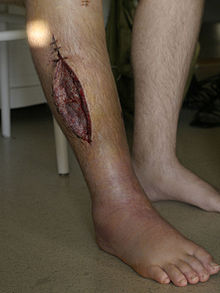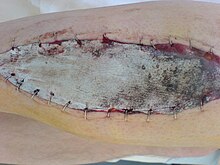Fasciotomy
The fasciotomy ( lat. Fasces bundle packet; Greek. Temnein cut (decomposed) share), also fasciotomy is an operating procedure for discharge of pressurized muscle compartments by separation of the respective fascia . The fasciotomy is primarily used in the treatment of compartment syndrome , where it has to be performed in an emergency. If performed quickly, fasciotomy has high success rates and low complication rates.
Action
At the affected area, access to the fascia is created through a skin incision (surgical intervention that only cuts the skin but does not affect the underlying structures). This is then split, which quickly relieves the pressure on the anatomical structures in it. The wound is not closed again directly, but left in such a way that sufficient protection of the tissue is guaranteed without the risk of renewed pressure build-up. Only after the swelling has subsided is the fascia closed again with a secondary suture (delayed wound closure). Under certain circumstances, a split- thickness skin graft may be necessary if the wound edges cannot be adapted without building up pressure.
Indications
- Compartment syndrome
- Dermatoliposclerosis
- therapy-resistant leg ulcer
- Phlegmasia caerulea dolens
Complications
The skin incision results in the formation of scarred tissue. Depending on the disposition, it can lead to keloids . A thickening of the scar tissue near the joint can lead to functional limitations. Furthermore, the incision can lead to accidental damage to nerves.
Individual evidence
- ^ GW Sheridan, FA Matsen 3rd .: Fasciotomy in the treatment of the acute compartment syndrome . In: Journal of Bone and Joint Surgery , Vol 58, Issue 1, pp. 112–115 (1976), ejbjs.org ( Memento of the original from July 27, 2008 in the Internet Archive ) Info: The archive link was automatically inserted and not yet checked. Please check the original and archive link according to the instructions and then remove this notice. Retrieved November 19, 2007.

